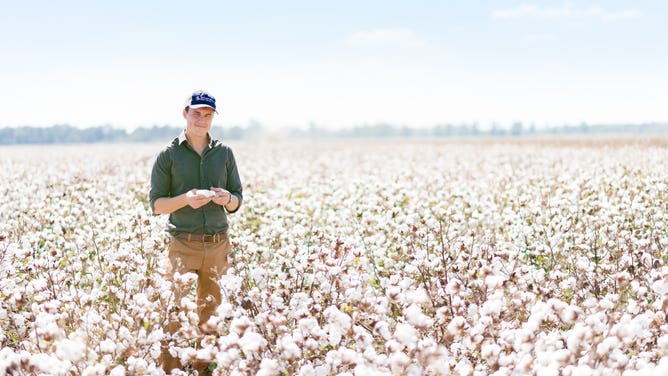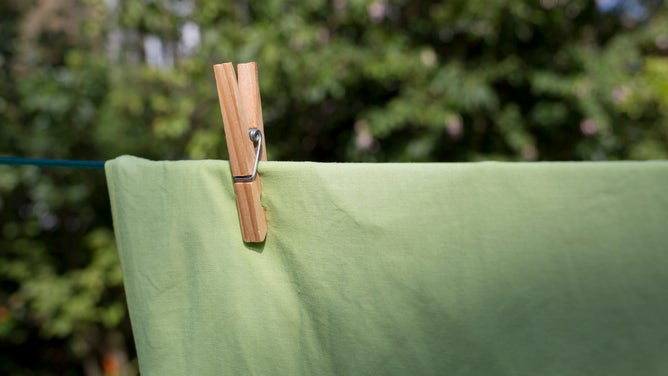Are those jeans sustainable? How to make clothing choices with less impact on Earth
Buying biodegradable fabrics helps prevent microplastic pollution

Florida, Orlando, Walt Disney World Resort, Levi's jeans store merchandise display. (Photo by: Jeffrey Greenberg/Education Images/Universal Images Group via Getty Images)
(Getty Images)
Taking time to consider your clothing fabric and how it was made can help prevent the increasing problem of plastic pollution while also being in vogue.
With a little more time and effort before your next shopping spree, those new jeans could last longer and have less impact on the planet. Getting a new dress or shirt via next-day delivery might seem like the greatest gift of the 21st Century, but that immediate gratification comes with a cost.
When designers and fabric companies make sustainable choices, those trickle down to the consumer.
Retired NASA Astronaut Karen Nyberg recently launched a fabric line called "Earth Views" with Robert Kaufman Fabrics using images she took of Earth during her time on the International Space Station.
"One of the main things is bringing attention to the beauty of Earth and just making people think about that," she said.
While looking down on our planet from space, astronauts describe experiencing the "overview effect" that changes how they think about Earth. Nyberg described having a similar experience and how it led her to include Earth awareness in her post-astronaut career.

NASA Astronaut Karen Nyberg in the International Space Station cupola looking at Earth.
"Seeing the Earth from that vantage point, seeing the blackness around it and realizing that Earth is just really this lone entity just hanging there in space and that everything on Earth is one entity and everything on it is connected," she said. "It is our only home. It's our home. And so that aspect of it and really realizing that the Earth is a special place and it's a place that we need to be very cognizant of conserving for next generations."
RELATED: How viewing Earth from space inspired NASA astronaut's new fabric line
Nyberg said going with organic cotton fabric was intentional for a line dedicated to Earth's beauty.
"I think it is important that we're at least cognizant of those things and how much water we use and what kind of chemicals we use when making fabrics," Nyberg said.
What makes sustainable textiles better for the environment?

Dr. Jesse Daystar, chief sustainability officer with Cotton Inc.
Even if the material isn't organic, there are still practices farmers and fabric makers can implement to make textiles sustainable.
Organic cotton is one variety of cotton growing. Still, it only makes about 1% of cotton produced in the U.S., according to Dr. Jesse Daystar, the chief sustainability officer with Cotton Inc.
Conventional cotton growing might have synthetic inputs, but in this method, farmers use traditional breeding to get their cotton seeds, not genetically modified seeds.
"There's also transgenic cotton production, which means you're using technology in the seed that can actually help repel bugs, which is really a neat thing that the technology can put technology into the plant that really helps the plant grow and be more healthy," Daystar said.
The third way is organic, which is regulated by the National Organic Program in the U.S. Organic cotton farmers can't use synthetic fertilizers or artificial inputs.
"It's a little bit simpler of a production process in that you don't have all the tools that perhaps other cotton growers would," said Daystar, who is also an assistant professor at Duke University, Nicholas School of the Environment.
With fewer tools like synthetic seeds or fertilizers, organic cotton can be more costly to the consumer because it's harder to grow in some areas of the country, depending on the soil, bugs, and weeds.
Daystar said it's challenging to compare environmental impacts to different growing methods. A side-by-side, peer-reviewed study comparing the U.S. cotton industry method hasn't been done yet.
Cotton is a hearty crop grown across areas of the southern U.S. known as the Cotton Belt, and roughly to thirds of cotton farms don't rely on irrigation. They work with the rain that exists, according to Daystar.
"So it's all about using the water and the resources you have and using them very efficiently to maximize your yield and lower the environmental impacts," Daystar explained.
Sustainable, but make it fashionable

Green sheets dry on a washing line in a back garden in London, England. (Photo by Richard Baker / In Pictures via Getty Images)
(Getty Images)
There are steps consumers can take to lessen their carbon footprint with their fashion choices.
For one, Daystar said washing your clothes in cold water requires less energy and produces fewer greenhouse gas emissions. Line drying might take more time, but it will also help your clothing last longer and conserve energy.
"When you look at the environmental impacts of, say, a T-shirt, roughly half the environmental impacts occurred during your washing and drying of your clothing," Daystar said.
It's essential to check the tag on clothing before you buy. Those new jeans could be adding to the increasing problem of microplastics pollution if clothing contains plastic-based threads such as acrylic, nylon, or polyester.
"Whenever you buy a polyester clothing, the production of it, and particularly the wearing and washing and drying, the little pieces of fiber actually shed off of our clothing," Daystar said. "And those are little pieces of plastic that go into this world and can have environmental impacts."
A 2019 study found that humans consume about a credit card-worth or roughly 5 grams of microplastics a year.
Choosing a biodegradable fabric will help reduce plastic pollution overall and keep those favorites in your closet for much longer.
"Clothing rich in cotton that is very durable, like pair of jeans I've had for years now. Those are really going to be more sustainable in a lot of ways because we can invest in the production of it once and then use it many, many, many times through years," Daystar said. "So fast fashion is not necessarily thinking that way. It's more keeping up with the trend and making something less durable."